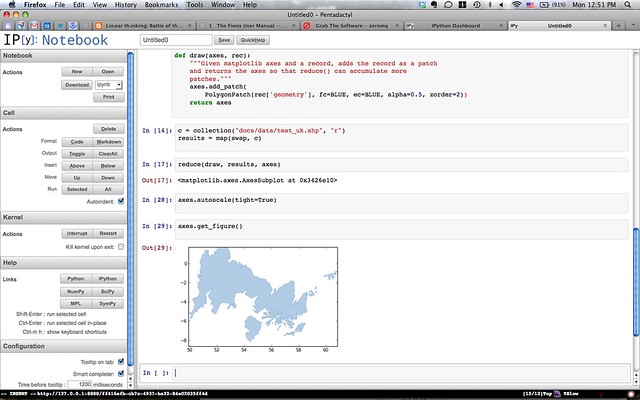Yesterday I read Melissa Terras On Making, Use and Reuse in Digital Humanities:
That's right. The code we made is now in use by another institution, to do
their own transcription project. Hurrah!
It was always our aim in Transcribe Bentham to provide the code to others: it
was a key part of our project proposal. But you always have to wonder if that
is going to happen. Its the kind of thing that everyone writes in project
proposals. And whilst lots of people talk about making things in Digital
Humanities, and whether or not you have to make things to be a Digital
Humanist, we've shied away - as a community - from the spectre of reuse: who
takes our code and reappropriates it once we are done? How can we demonstrate
impact through the things we've built being utilised beyond just us and
- quite frankly - our mates?
So I'm happy as larry that the code we developed, and the system we have
built, is both useful to us, but is now useful to others. I'm not sure how
much I want to prod the sleeping monster that is general code reuse in
Digital Humanities... dont draw attention to our deficiencies!
But I would be delighted if anyone else could point me to examples where code
and systems in Digital Humanities were repurposed beyond their original
project, just as we would wish?
I was unable to persuade Recaptcha to let me leave a comment and
congratulations on Melissa's blog, so am writing a brief post here. TL;DR
Transcribe Bentham: congrats! My own horn: toot! toot!
To my knowledge, no one has set up another instance of Pleiades as a gazetteer.
But code written for Pleiades gets reused more and more widely the further down
in our stack you look. I designed it to be modular and reusable – a stack of
tools, not a single tool – so I'd be disappointed if that wasn't the case. I'll
explain how it works for us.
Pleiades uses the Plone (and Zope) web application framework. Our Plone
products and packages have taken on a life of their own as the collective.geo project.
IW:LEARN is a good example
of a collective.geo site. Contributions to collective.geo by almost 20 other
people have been making Pleiades better. And this is just the start of our
reuse story.
Pleiades and collective.geo Zope and Plone packages are based on Python GIS
packages spun off from Pleiades such as Shapely, Rtree, and Geojson. At PyCon
a couple of weeks ago, I ran into a lot of Shapely users. I saw it mentioned on
slides in talks and on posters in the poster session. Famous web and geography
hackers even write about using Shapely from time to time.
Shapely feature-wise, Pleiades now gets as much back from others as we give
out.
This is a fantastic position to be in.
Digging deeper in the stack, I've contributed (as "sgillies") to the development of GEOS as
part of my work on Pleiades, so Pleiades has thereby played a tiny role in
making thousands of open source GIS programs and web sites more spatially
capable. A Python protocol for sharing geospatial data that we invented for
Pleiades has been implemented rather widely in GIS software. Anywhere you see
__geo_interface__ and shape() or asShape(), or programmers sharing
data as GeoJSON-like Python mappings,
that's the impact of Pleiades. The GeoJSON format
itself has some of its roots in Pleiades.
Even if no one ever sets up another Pleiades site, we're having a significant
impact on GIS software and systems, even on big time GIS software being used
for Spatial Humanities work. The keys to having a similar impact are, in my mind, 1)
modularization and generalization to increase the number of potential users and
contributors, and 2) a policy of open sourcing from day zero instead of open
sourcing after completion of the project – and after people have lost interest
and moved on to other software.

Comments
Re: Reintroducing a Python protocol for geospatial data
Author: `Stanley Fish <http://law.fiu.edu/faculty-2/stanley-fish/ >`__
Dear Mr. Gillies,
In truth it was your somewhat reductive blog post on Python's reduce() function on which I wished to comment, but I find myself thwarted by your practice of shutting down all reader commentary after a fortnight has passed -- something even I have not yet been accused of doing.
I thought you would like to know that I have made reference to your scintillating work on the Pleiades project in my fourth essay on the so-called "digital humanities" movement. These are to be found in my New York Times column (not to say, blog). I would be interested in your thoughts: http://bit.ly/H4Suf4
Sincerely,
Stanley Fish
Re: Reintroducing a Python protocol for geospatial data
Author: Sean
Ho, ho. For readers outside of academia: Stanley Fish is an English literature professor and opinion writer for the New York Times who has lately been winding up my digital humanities colleagues. Some Background: http://www.bogost.com/blog/this_is_a_blog_post_about_the.shtml.